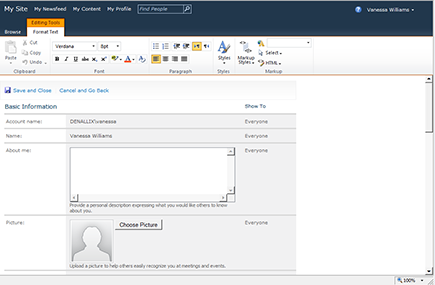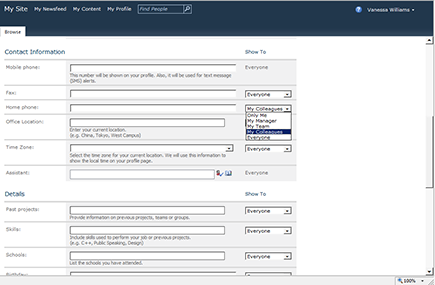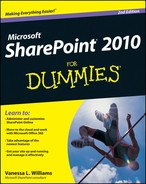Figure 15-1: The My Profile page of a My Site.
Chapter 15
Managing Your User Profile
In This Chapter
![]() Viewing RSS news feeds of your SharePoint lists
Viewing RSS news feeds of your SharePoint lists
![]() Displaying RSS feeds from Outlook
Displaying RSS feeds from Outlook
![]() Viewing RSS feeds of other sites
Viewing RSS feeds of other sites
![]() Subscribing and managing alerts
Subscribing and managing alerts
People are central to any business, no matter how big or how small. Without people, also known as employees, a business wouldn’t run. How people interact with each other creates the culture of a business, and part of that culture is how people figure out who does what job, who knows who, who knows what, and how someone might be able to help you do your job better. That culture, to some extent, can be reflected in SharePoint user profiles, and the better the user profile, the more likely you’re going to get your job done more effectively. And, the more likely others are going to be able to find you easily when they need to.
Creating a Holistic Profile Experience
The first part of your creating your profile is to take a look at what properties are there by default. Many of the basic properties come from Active Directory (AD), but depending on how SharePoint was set up, you could also see information from other systems in there as well. The AD properties that typically show up in user profiles include your name and account name, title, department, manager, and some contact information such as your work phone.
Then there are other properties that you can update on your profile page, such as About me, your picture, your location, your home phone, your skills, interests, and projects you’ve worked on in the past. All of this extra information creates a much better sense of who you are than just the basic information about who you work for and where you are.
These can be edited by browsing to your My Site, clicking on My Profile, and then clicking the Edit My Profile link under your picture (or where your picture should be — upload one now!). Another way to get right to you profile page is to simply click My Profile from the drop-down list on your user name, as shown in Figure 15-1.
You’ll find out more about the rest of the items on the My Profile page in Chapter 17, but for now, stick to the actual details of your profile.

Updating Basic Profile Information
It seems like practically everyone in the world is familiar with and probably uses social networking sites like Facebook, Twitter, and the like, and SharePoint 2010 has taken some cues to extend that social networking functionality into SharePoint. It all starts with sharing some information about yourself so that other people in your organization can find you and read a little about you. That’s where the basic profile information comes into play.
Along with the really basic information that comes from Active Directory (AD), you’ll also see About Me, Picture, and Ask Me About fields when editing your profile, as shown in Figure 15-2. These items are shared with everyone, unlike some of the extra information I cover next.
The information you share here should be what you want people to know about you as it relates to what you do at your company. There’s really no need to share your love of pet rats here unless your business caters to owners of pet rats. Rather, share a little bit about where you came from, what you like to work on, and when you started at the company — keep it simple and useful for others.
Figure 15-2: Editing basic profile information.

In the Ask Me About section, put in what you’re really good at, work-wise, and things that people might want to know more about you if they knew you had the same interests or a particular knowledge of something they need to know more about. But again, keep it business-related because this information is shared with everyone.
For your picture, maybe opt for the one of you in business attire instead of that one of you sunburned from a day at the beach? Remember, the picture you share here shows up in SharePoint, attached to documents you’ve created or when you show up in search results. A picture is really helpful, for example, if you work in a large organization, and even a small to medium-sized organization where people don’t work in the same location. Maybe all the employees of your company are so distributed that they don’t all get together but once every year or two, so being able to place a face with a name can help bridge that gap of unfamiliarity. I’ve been in many situations where the voice doesn’t go at all with the eventual face when I met them in person — this helps to alleviate some of that awkwardness.
Taking Your Profile to the Next Level
Filling in the rest of your profile is up to you, one of the cool features of the Contact Information and Details sections of your profile is that you can choose who you share that information with.
Controlling who sees what
As shown in Figure 15-3, there are a number of details you can fill out about yourself, and you have five options for who gets to see that information. For example, your Home Phone might be great to share with those you work closely with, such as your colleagues, but would you want everyone in the company having access to that information? Probably not, so you leave that one with the default of My Colleagues. Heck, if you only want to share that with your manager, choose that instead. Your options are
![]() Only Me meaning you can put some information in there that won’t ever be shared with anyone.
Only Me meaning you can put some information in there that won’t ever be shared with anyone.
![]() My Manager, which lets her get access to some information that may be important.
My Manager, which lets her get access to some information that may be important.
![]() My Team is your immediate group of people who work for the same manager.
My Team is your immediate group of people who work for the same manager.
![]() My Colleagues is the list of those you’ve added to your My Site, who you get status updates about, and who shows up on your Colleagues tab of your My Profile page. You can add, edit, and remove colleagues as you see fit.
My Colleagues is the list of those you’ve added to your My Site, who you get status updates about, and who shows up on your Colleagues tab of your My Profile page. You can add, edit, and remove colleagues as you see fit.
![]() Everyone is anyone who is authenticated and can access SharePoint.
Everyone is anyone who is authenticated and can access SharePoint.
Figure 15-3: Adding more information to your profile and choosing who to share it with.

Keeping it fresh (and real)
If you’re on Facebook, you know that people who usually post often are usually the most interesting. (Well, at least they’re the most interesting online.) Same thing with your profile. Adding some pithy or clever remark, or making sure nobody bugs you today because you’re not in the mood, are two approaches to filling in the “What’s happening?” portion of your profile. If you use Lync or some other instant messaging program, it’s the same thing as the “What’s Happening Today?” status, so go ahead and let people know what you’re excited about today.
To make your profile interesting, you can change your picture every now and again too. That web cam shot of you working your tail off in the middle of the night may not be the best, but it definitely tells a story of its own.
Keep it fresh, keep it real, and don’t be afraid to let people know how you feel.

 After browsing around your profile and the different sections of it, if there are properties that you’ve seen in the Outlook address book that you think really should be in your profile and other people’s profiles, ask your SharePoint administrator to get those properties into SharePoint. This task is done in SharePoint Central Administration.
After browsing around your profile and the different sections of it, if there are properties that you’ve seen in the Outlook address book that you think really should be in your profile and other people’s profiles, ask your SharePoint administrator to get those properties into SharePoint. This task is done in SharePoint Central Administration.